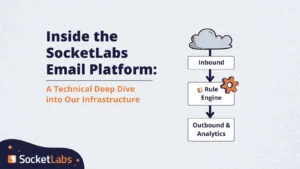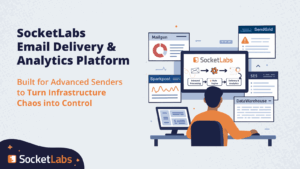Hurricane MTA Server 2.0 is the next evolution of our high performance, high deliverability MTA. We have increased performance and expanded beyond just SMTP email delivery. See for yourself why this release makes Hurricane MTA Server the most advanced MTA on the market.
New Higher Performing Email Delivery
Hurricane MTA Server 2.0 has been upgraded to the .Net 4.0 framework, which has enabled us to do such things as use enhanced asynchronous patterns that reduce memory consumption and increase I/O performance. We take further advantage of the optimized threading and locking architecture in 4.0 that results in additional performance gains. Our customers get the benefit of writing server plug-ins that take advantage of many of the efficiency gains provided in the 4.0 framework making integration tighter and high performing. We estimate up to a 30% increase in overall performance from the upgrade to .Net 4.0.
New Event Engine Brings Queuing and Delivery Tracking to HTTP/S Post Events
The new Event Engine in Hurricane MTA Server is a powerful new way to queue and deliver any HTTP/S Post message. Fast becoming the preferred communication protocol for cloud-based services, Hurricane’s Event Engine is the first of its kind to provide a reliable, scalable delivery mechanism for high volume HTTP/S Post messages. Similar to SMTP messages, the Hurricane Event Engine can accept, queue and deliver HTTP/S messages and re-queue any message that isn’t accepted on first attempt. Re-queued messages are then retried on a specified schedule, for instance every 2 hours for 2 days. No longer do you need to build this level of scalability and redundancy to your applications which may be communicating with multiple cloud-based services.
In addition, the Event Engine can be configured within Hurricane MTA Server to send HTTP/S event messages for Sent, Failed, Bounced and Feedback Loops to any application. Hurricane MTA Server is the first in the industry to enable message notifications for sent, failed, bounced and feedback loops to any URL of your choice without having to write a line of plug-in code or scrape information from log files. The Event Engine can communicate with any HTTP/S server, written in any language, on any OS. Application integration has just become even simpler with the addition of message events via the Event Engine.
Automated Log and Database Maintenance Ease Operations Workload
Common operational issues for server software can become critical problems if not managed properly. Writing custom scripts for purging log files or removing old data from databases can become problems in their own right if not maintained properly. SocketLabs takes these operational issues out of your hands by incorporating scheduled log and database cleanup.
Log files can pile up quick and take up storage. Hurricane MTA Server enables you to schedule a log cleanup or purging based on file age. You can schedule a global schedule or individually schedule specific log files to be cleaned up. Now you never have to worry about running out of disk space.
The statistical and alerting database in Hurricane MTA Server can expand quickly and bog down system performance. By scheduling a regular clean-up operation the database can be regularly trimmed to keep performance high and to avoid database corruption.
Viewing Message Contents in Queue Gives Greater Operational Insight
The queue management tool within Hurricane MTA Server revolutionized MTA queue management upon its release. Never before had SMTP MTA administrators been able to visually see the breakdown of messages in mail queues all the way down to the status of each individual message. SocketLabs expands this capability by enabling you to view the actual contents of any message in queue from within the administrative console. Now operators will know exactly what messages are being held in queue and can react accordingly.
Multi-sign Messages with DKIM Drives Increases in Deliverability
Trust is one of the keys to effective email delivery. Most ISPs today prefer the use of DKIM for authenticating email messages. Hurricane MTA Server has supported the signing of messages with DKIM since its inception. We have now expanded that support by allowing for multiple DKIM signatures per message. So why would you want to sign your email with multiple DKIM signatures? Well, for customers sending email for other companies this would enable you to sign on behalf of your returnpath domain (that you collect bounces on) so you can receive ISP feedback loops, as well as your customer’s from domain for increased deliverability, display and treatment of the message by the ISP.
Delivery Rule Enhancement Increases Deliverability to Certain Domains
Delivery Rules are at the heart and soul of the Hurricane MTA Server. They enable you to intelligently delivery email to specific domains so you have the greatest chance of your email landing in the inbox. SocketLabs expands the power of delivery rules by enabling you to turn off the VERP encoding of the return-path for specific domains. Why would you want to do such a thing? Some services like fax services authenticate your messages based on the registered return-path domain. If your return-path doesn’t match your registered domain they won’t accept your message. Additionally, some email services like Gmail will display the return-path domain if it is different then the from domain. This may not be an ideal situation and Gmail doesn’t support bounces therefore it is not necessary to send the VERP encoded return-path. By turning off the VERP encoded return-path in the delivery rule you can easily support either of these scenarios.
Additional Return-path Domains for a Single Account
Automatic bounce processing is another key feature of Hurricane MTA Server. In Hurricane MTA Server 2.0 we have expanded bounce processing by allowing for multiple return-path domains for each account (virtual MTA). Supporting multiple return-path domains allows you to change your return-path domain while continuing to support the original domain.
Amazon CloudWatch Integration Provides Real-time View into Hurricane Performance
For customers leveraging the Amazon cloud you can now include Hurricane MTA Server monitoring in with your Amazon cloud resources. With full integration with Amazon CloudWatch all Hurricane statistics and server health information gets reported directly to your CloudWatch instance for full view of health and performance of your Hurricane MTA Server. CloudWatch integration for Hurricane MTA Server enables you to set alarms for various server conditions, such as, the CPU usage is high, disk space is running low or there are too many messages in queue giving you unparalleled insight into the real time performance of your Hurricane MTA server.
To take advantage of this feature, you must have an Amazon Web Services account with CloudWatch which is a separate, paid service offered by Amazon.
Domain Redirection Increases Queue Efficiency through Merging of Related Email Traffic
Increasing queue efficiency and server delivery performance were paramount in the Hurricane MTA Server 2.0 release. One way we have achieved this is through domain redirection. What is domain redirection, you ask? The ability to merge email traffic from multiple domains into a common queue. Why would you do that? Well, several large ISPs (Hotmail, for instance) service several other domains that are serviced by Hotmail like msn.com or live.com. Traditionally these domains would all have their own queues, but since they all deliver to the same email servers they all fall under the same delivery rules. This can limit email delivery based on the limitation on connections in the delivery rules. By combining in this case msn.com and live.com email messages with all hotmail.com messages email is delivered more efficiently while maintaining the protocol of the delivery rules.







